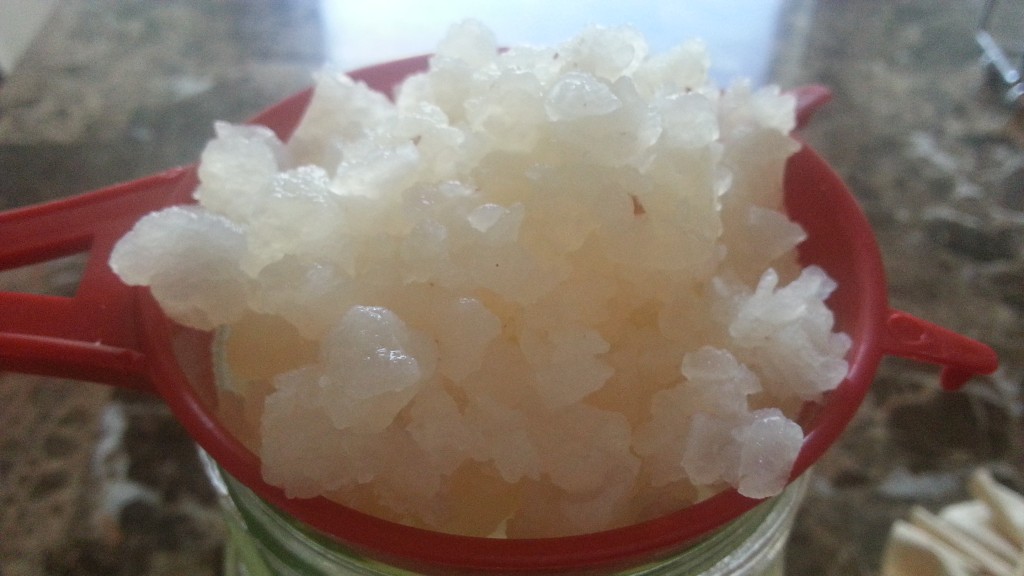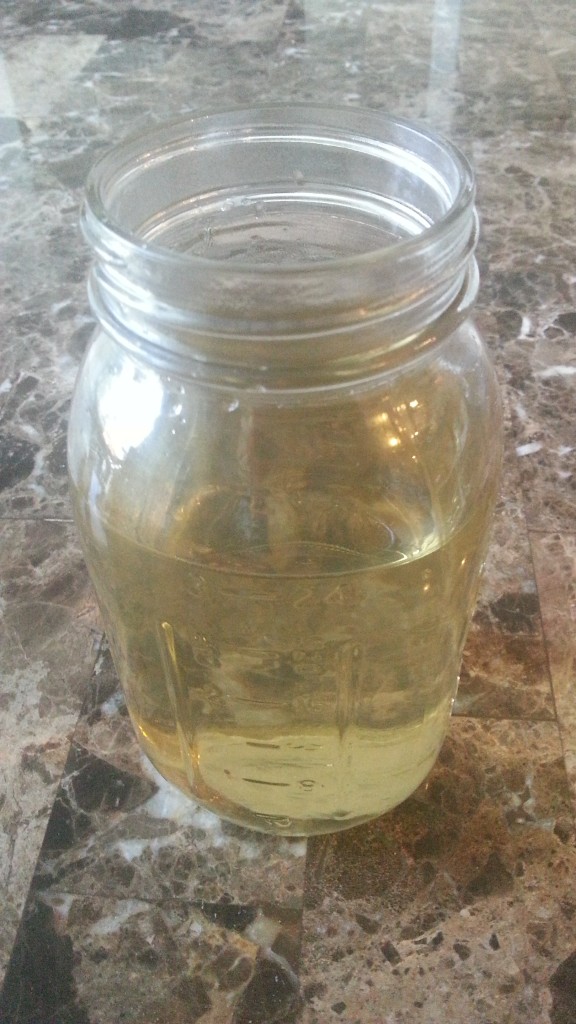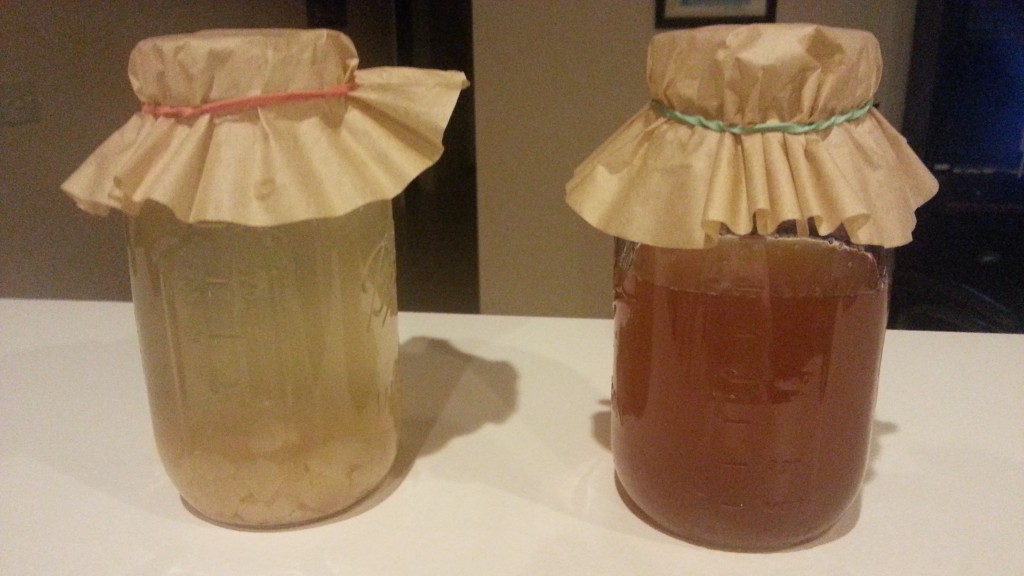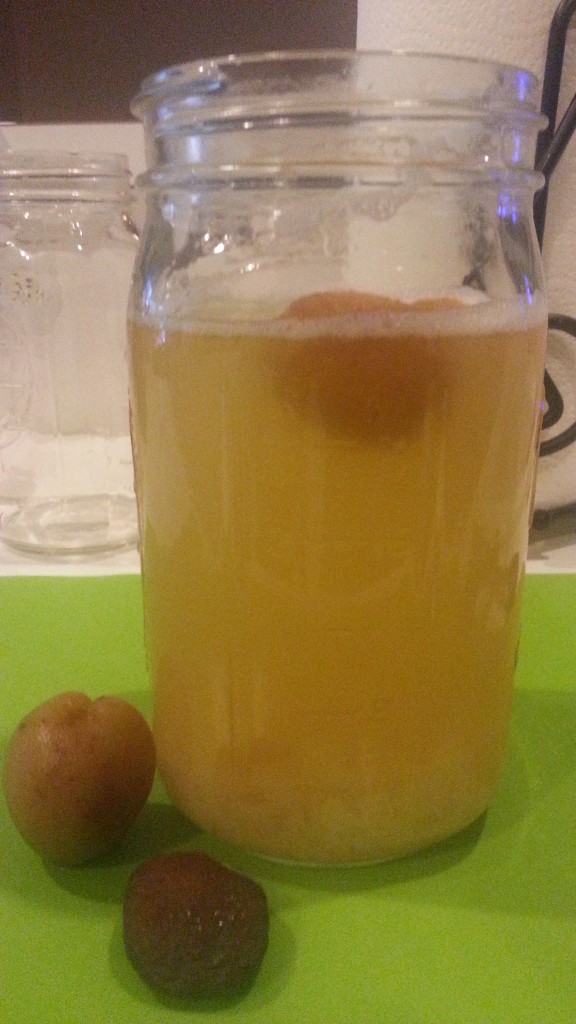
Water Kefir Grains
What is Water Kefir?
Water kefir is made from kefir grains, also known as sugar grains, tibicos, tibi, or Japanese water crystals. The grains make up cultures of various strains of healthy bacteria and yeast, held together in a polysaccharide matrix created by the bacteria. The symbiotic relationship of the microbes produces a stable growing culture. The microbes feed on sugar and produce lactic acid, alcohol (ethanol), and carbon dioxide, yielding a fermented carbonated beverage. The alcohol content is usually very minimal, less than 1%. In a nutshell, it’s a large dosage of Probiotics in the natural form.
What are the Autoimmune Natural Health Benefits of Water Kefir?
They are a natural supplier of Probiotics to our digestive track. Probiotics refers to the healthy bacteria that usually feed on the “bad” unhealthy bacteria in our stomach and intestines. Bacterial overgrowth can lead to many illnesses some of which include fungi, yeast infections, indigestion, obesity, Irritable Bowel Syndrome + Crohn’s Disease (my autoimmune disorder stems from these), skin disorders, etc. By drinking water kefir you will bring natural balance to your internal microflora. By contrast, there is milk kefir [review comparison], however the dairy in it could be problematic and thus the reason I use water kefir.
UPDATE 7/3/13 – CONFIRMATION THAT WATER KEFIR WORKS FOR GOOD BACTERIA – Review the Metametrix Gut Ecology Test Results for bacteria levels within my system. You will see the predominant levels of bacteria (the good ones) are high and the pathogenic / opportunistic bacteria (the bad ones) are low and this is due strictly to the water kefir. The only bacteria I need to supplement are the Bifidobacter and am taking a one month dosage to bring those levels up.
What are the Side Effects of Water Kefir?
Although some have reported candida-like issues, it usually stems from detoxification and only lasts for a few days. In my research, I have not come up with any significant side effects nor have I developed any major flare-ups while taking water kefir.
UPDATE 4/12/13 – Taking water kefir every morning 4-8oz. with no side effects except mucus with stool if I have too much water kefir. My body has improved since taking it and is one of the few enhancements / supplements I take now. Kefir grains stopped growing 3-4 weeks after shipment but that makes it easier to manage.
UPDATE 10/21/13 – INCREASED FUNGUS LEVELS: Review the Metametrix Gut Ecology Test Results for Yeast / Fungi and you will see an elevated level of Saccharomyces. If you read the various strains of healthy bacteria and yeast for water kefir, you will notice it contains Saccharomyces cerevisiae. After stopping the water kefir for over a month, I have seen no significant side effects or improvements taking away the water kefir. Therefore it is safe to say that the water kefir is benefiting me (due to increased good bacteria levels) and that this test shows I have an overgrowth of the good bacteria Saccharomyces cerevisiae and not the bad Saccharomyces.
UPDATE 5/17/15 – ACIDITY: After 5 months of being only on Humira 1X/mo, HCL tablets (scroll to item #3 after clicking link), and water kefir, I noticed higher levels of acidity in my esophagus, some heartburn (especially if I don’t take enough HCL from my other meals), and more burping due to carbonation. However, I solved this issue by diluting the water kefir, combining the drink with meals, and not letting it ferment more than 2 days (especially the more months you continue to ferment it). And I also determined that as each month goes by, the water kefir alcohol strength increases (drinking 1/4 – 1/2 mason jar in the morning will almost always give me a buzz in the morning).
How to Make Water Kefir
Tools Needed (Only use plastic / glass, no metal):
- Plastic strainer
- Plastic measuring spoons
- Plastic spoon or knife
- 4-Cup Glass Measurer
- Ball Mason jar 3 Glass Ball Mason jars
- Small coffee filter
- Rubber band
Ingredients Needed:
- Filtered or spring water
- Water kefir grains
- Organic cane sugar
- (Optional) Unsweetened, unsulfured dried fruit (apricots, figs or raisins)
- (Optional) Organic lemon / lime
My Simple Instructions:
Cut lemon / lime in half & then cut again to make 4 pieces. Add 4 Tbsp of organic sugar to 3 cups of spring water. Stir with plastic knife until sugar dissolves. Add in strained water kefir and 4 pieces of lemon / lime. Cover with the coffee filter and wrap with a rubber band for 48 hours in a cool, dry place.
After 48 hours, uncover & strain into a new Mason jar. Make a new water sugar solution into the 3rd Mason jar and repeat the steps shown above.
Here is a general video on how to make natural water kefir and what to look out for:
There are many varieties of making natural water kefir and changing the taste. Look at the video below for more info:
Where Do I Find Natural Water Kefir Grains?
I originally purchased the grains from Green Mom Zoe. Feel free to order from her & let her know you ordered from my site.
Photos of My Water Kefir Process




Cool Bri, can’t wait to try it.
Mom
very nice post. ive just made my first water kefir, excellent stuff!
Greetings and thanks from Norway
Great! Let me know if you notice any changes within two months.
I think it’s easier to keep grains alive if you dry them rather than freeze them. Just spread them out on some parchment paper on the countertop until they dry and they should keep for six months or so (you’ll have to go through the first few cycles of sugar water to revitalize them again).
I’ve also read that you should remove the grains before adding fruit or herbs or fruit juice to the kefir (and then letting it ferment at room temp for another 18-24 hours without the grains). One source said that fruit and fruit juice will ‘wear out’ the grains faster. I wouldn’t know. I’ve got so many I’ve taken to eating the actual grains just to keep the volume down. 🙂
Interesting, I thought they would die without the sugar water solution. I’ll have to try your drying method if / when I get a new batch of growing kefir grains.
Interesting you can add fruit & fruit juice to your kefir grains. The only type I use are unsulphured dried fruit – those grains LOVE them.
I get requests for water kefir grains. If you’re interested in selling them, fill out the contact form as I just got a request in yesterday.
I’ll do that. I’m just making a new batch of kefir with some grains that have been in the fridge in sugar solution for a few days, so I’ll be able to tell if the refrigeration actually hibernates them or not. And I have my first batch drying. Would be happy to sell some if there’s a need.
In other news, yesterday I got bored and mixed some of the grains with organic cocoa powder, raw honey and almonds. Very tasty!
Lilly, how did the drying and/or other methods you tried of hibernation turn out?
I bought mine on ebay fresh, they were not dried. Have been working great and multiplying.
I like to “brew” the water kefir in a jar on the countertop with sugar only. When this stage is finished and the grains are strained (I use a plastic sprouting jar lid for a strainer which means the grains stay in the jar) then I put a sliver of lemon peel, a cube of candied ginger, a sliver of orange peel into the freshly made kefir. This goes into the refrigerator and the addition stays in the jar until it’s used up. I do use a fresh peel or cube each time. The taste is refreshing. I keep grains in a glass jar with fresh water and a 2 tbs of sugar between fermenting times as I am the only one in my household using it. I make half gallon batches at the time.
I have had to get used to the taste and the lemon, orange, and ginger have helped out a lot. The person from whom I purchased the grains used brown sugar with molasses, but I didn’t like that flavor. I feel so much better when I drink water kefir daily.
I like your idea of the plastic sprouting jar as it looks like it would make less of a mess. When you make 1/2 gallon batches, are you taking them from multiple days of fermented water kefir or multiple water kefir mason jars at one time? I ask because each of my mason jars make 3-4 cups of water kefir per batch. Lastly, have you taken any gut ecology tests to see your levels of good bacteria?
I use a half gallon jar and pour the “finished” kefir into separate jars for the different flavors. I would really like to take a gut ecology test; what do you suggest?
Rereading my post, I see how unclear it is; each “flavor” ingredient is in a different jar after the plain kefir is “brewed”
You could do the same with the jars you use.
OK, that makes sense now. You start with a base water kefir & then add in later similar to the video on this blog post. For the gut ecology profile I took, go to https://100percenthealth.us/year1-2/autoimmune-mold-enbrel-root-cause/. Scroll down to the area titled “Confirmation Autoimmune Test – Gut Ecology Profile” to get my test results from Metametrix.
it is normal to have a little funny fealing the first time like you are a lil drunk i just have it for 24 hours so i dont know, my kefir is more confy when it have a dry fruit inside i see more activity… how can i make it grow more faster
Since the sugar water coverts / ferments into a drink it does make it a slightly alcoholic drink. Since dried fruit has it’s own sugar, it makes the water kefir grow quicker / make it stronger. As you create more batches, it can get stronger and the longer you leave it (1 day vs. 3 days for example) that will make the fermentation process longer thus increase the alcoholic level.
That one looks delicious. I just started doing the amazing water kefir 3 days ago, the first 12 hours I had not the right sugar, and the grains had an alcohol smell. Here is my second batch with organic cane sugar, the grains are proliferating very fast. And by the way thanks to Cultures for health for their great knowledge.
I’m in the midst of a new batch (started a few weeks back) and noticed that I can let it ferment for 5 days without issue. So feel free to let it ferment until your desired taste knowing the kefir grains won’t degrade until (at least) the 5th day. After 48 hours I tend to find that my kefir turns into the alcohol / beer taste (and yes you can make beer out of it – http://www.traditionaltx.us/KefirBeer.pdf) but I know that I’m not drinking any sugar water (which has given me a hypoglycemic sugar surge in the morning). Your photo looks great – nicely lit. I tend not to add in any small fruit as it’s harder to pick out. Two dried apricots seem to do the trick each time. Keep up the good work.
Hey Brian, thanks for the reply 🙂 I let this batch fermented for 45 hours, I’ve bottled the water. Now I’m waiting them to do some fuzzy bubbles. I will check tomorrow. But I forgot to strain the grains with my tiny special strainer I got from health store. So there remain some of them but very little grains in the bottom. Should I strain them again? Can I eat them? I don’t like to much sugar me too, no problem that I know with my sugar, I just don’t like to eat too much sugar. ButI don’t like alcool taste too much either. I’m preparing myself to make some Lacto-Fermented Vegetables soon and found some equipment at the beer brewing local store and I will try to get one of those hydrometer and alcool meter to read the sugar and alcool.Should be interesting to experiment. 😉 check this out this is my next move 🙂 http://www.instructables.com/id/Making-a-Probiotic-Ginger-Beer/
I just noticed my reply from last week didn’t post. You won’t need to strain them again as they fine to eat and your other kefir grains will continue to grow. Please let me know how the much alcohol content you measure. I’m quite curious.
Hey Brian if you want you can follow me on facebook into the group I Love Water Kefir! I post as Danny Côté. It would be nice to exchange idea with you and the others, people are very friendly there.
https://www.facebook.com/groups/112347725454845/880669795289297/?notif_t=group_comment
Thanks for the offer. Just joined & waiting approval.
Very good, i’m glad. 🙂
I added cranberry and pomegranate juice
I add cranberry and pomegranate juice
Valuable suggestions , Just to add my thoughts , if your company needs to fill out a HI DOE OHR 600-001 , my business filled out and faxed a template document here
https://goo.gl/5EqMHXI cannot find anything online regarding the glycemic effects of water kefir on people with glycemic disorders. I understand that the bacteria eat the sugar in the water kefir, but it is still sweet, so what to do if you have issues of balancing sugar levels? Does anyone have a good link to share of someone knowledgable regarding this? I can only find information on milk kefir when I do searches online. I specifically want to know about water kefir. Thanks!
Hi Syrena. I have been looking for similar information. Not because I have a glycemic disorder, I’m just curious about it. One reason that might make it hard to quantify is because there are so many variables between batches and sweetness is subjective (what tastes sweet to me tastes like vinegar to my hubby). Variable like amount of sugar to start, length of ferment time/temperatures during fermentation and health of the grains are just a few that come to mind. I think you’d really just have to experiment for yourself by checking your glucose reading before and after consumption just to get an idea. But the again, it will likely still vary batch to batch.
Thank you for the reply. I didn’t find it to spike my glycemic issues, but had to stop taking it because of candida flare up. I am now going to try the water kefir grains in apple juice to see if it was the sugar that caused the flare up, or was it the yeast in the grains? If it was the yeast, it will likely flare the problem, again. If the cane sugar, then I will likely do ok using the apple juice, because I don’t seem to have problems with small amounts of juice. Experimenting to try to get the most from probiotic foods. Thanks!
If you are having candida issues, raw milk kefir would be a much better choice. Raw milk kefir keeps candida in check. If you must use apple juice, I would only use organic non-pasteurized apple juice/cider. Pasteurize store bought apple juice is not a good choice for water kefir.
good bacteria don’t “eat” bad bacteria…(I refer to the section where you state the good bacteria “feed” on the bad bacteria) bacteria are similar to humans. Imagining theres only so much “space” in the gut; and not all environments are favourable to all bacteria… by providing an environment that promotes one bacteria over another ; or providing cultures of one bacteria (and not another) is similar to promotion of migration to Australia from certain countries… Australia would then be likely to have more migrants from those who are encouraged to enter.
PS. I really enjoy drinking water kefir, its quite tasty and fun drink. An alternative to water or tea.
My significant other is hypoglycemic. The only kind of sweetener he can eat in small quantities is coconut palm sugar. We are hesitant to use cane sugar of any kind because of the severe reaction he can have to it in it’s regular form. I have been told that once the grains consume the sugar to ferment and produce the probiotics, there is not sugar left for us to consume. Is that correct? I need to know for sure before he tries some. We have made some with coconut palm sugar and it will be finished in it’s second fermentation tonight, but I have read that coconut palm sugar can damage the grains and may not have a typical kefir flavor?
For me, leaving the water kefir ferment for a few days left little, if any sugar. And as it progressed, it became more and more acidic. If you want to be on the safe side, ferment it longer and try it yourself before you give it to your significant other. There may be tests for detecting sugar in your water kefir but I have not tried any.